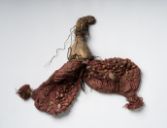Going Bananas
Step number nine. This step shows a bundle of fabric, shrunken together from already being dyed red at the edge. The centre has been wrapped and tied in a larger piece of banana leaf to stop the dye from reaching the centre. It represents how to get between Steps 3 and 4.
At first glance, the leaf looks as if it were part of the fabric itself because it is illustrated as still green. Time has decayed its natural properties, and now the difference in colour and texture is striking. Like the painting stick, the illustration also depicts this object as much bigger than it really is! It becomes the centre of the illustration, but after dyeing it has shrunk just as much as the other small objects in the collection.
The humble banana is used throughout the process, its properties being important to the success of tie dye. Its waxy leaves resist the dye and it is flexible enough to be bent and tied with the fabric. The fruit itself was also useful in the creation of an accurate blue dye in Step 6. Nature was at the heart of these traditional processes that would eventually be redeveloped on other continents.

